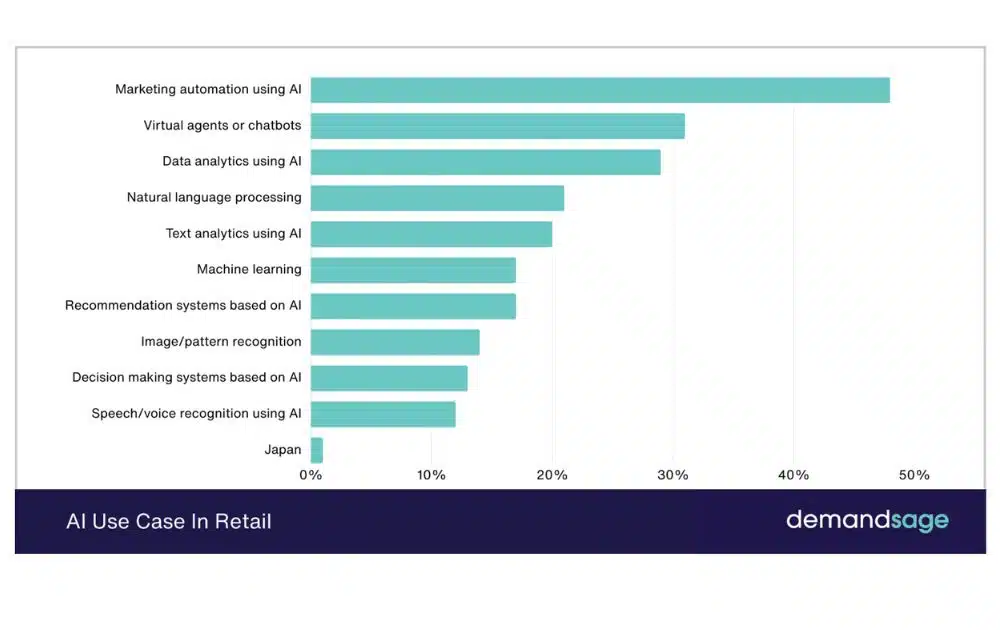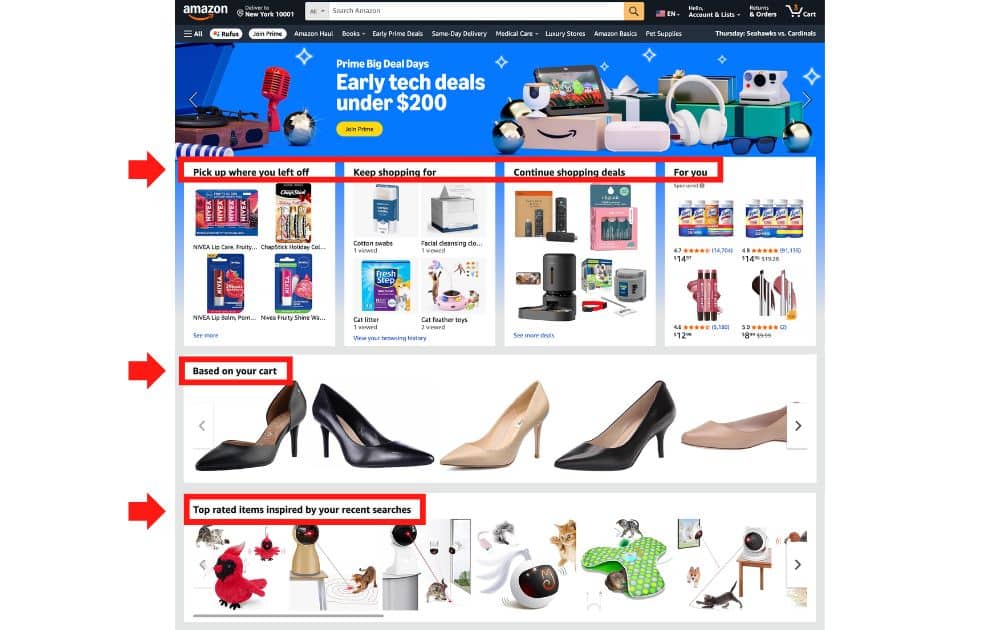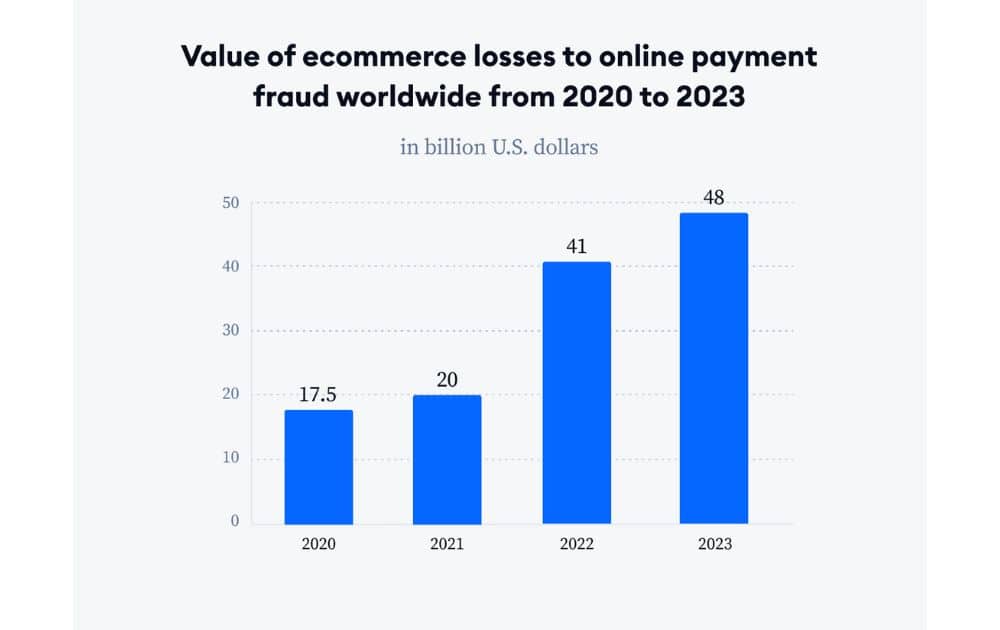AI-Driven Personalization Strategies
AI-driven personalization is already the engine quietly transforming how high-growth brands connect with their customers.
Nearly half of retailers already use AI for marketing automation, making it the single most common application in the sector. Close behind are virtual agents and chatbots, followed by data analytics.

These AI tools are shaping the very moments when a shopper decides whether to browse, click, or buy.
Artificial intelligence in eCommerce allows shoppers to shift from generic, one-size-fits-all campaigns to experiences tuned to the individual, including what they want, when they want it, and even how they prefer to be spoken to.
What Is AI-Driven Personalization?
At its core, AI-driven personalization is the practice of tailoring every touchpoint in the shopping journey with the help of artificial intelligence. Instead of sending the same promotion to everyone, AI analyzes patterns in:
- Browsing behavior
- Purchase history
- Contextual signals like time of day or device used
The result is a shopping experience that feels curated rather than generic.
Marketers often take this a step further with hyper-personalization marketing. Here, the focus isn’t just on broad segments such as “new” or “loyal” buyers. Instead, the system offers product suggestions in real time, tuned to the individual’s needs at that exact moment.
Take Amazon’s homepage as a case in point:

The screenshot above highlights several personalization modules:
- “Pick up where you left off,” “Keep shopping for,” “Continue shopping deals,” and “For you”: AI tracks unfinished browsing sessions and nudges the customer back toward items they almost purchased, reducing friction.
- “Based on your cart”: Here, the system uses cart data to surface complementary items—in the screenshot, shoes appear alongside related product suggestions.
- “Top rated items inspired by your recent searches”: This is where predictive insights shine. Amazon connects past search behavior with highly rated products to increase relevance.
These modules show how hyper-personalization adapts in real time, combining browsing history, cart activity, and search patterns to deliver suggestions that feel intuitive. It’s almost like a personal shopper who already knows what you need next.
AI Keywords
One of the most powerful enablers behind this approach is AI keyword search. Traditional search engines rely on literal matches, but AI understands intent and context.
If a shopper types “comfy shoes for long walks,” the platform can infer that they’re looking for cushioned sneakers, even if those exact words aren’t in the product title. This smarter search function does a few things:
- Reduces friction
- Boosts discovery
- Keeps customers engaged.
Ultimately, AI-driven personalization reshapes your customer relationships. It turns a static online store into a responsive environment where the shopper feels recognized, understood, and valued at every click.
Benefits of AI in Ecommerce
Personalized shopping experiences
AI-driven personalization allows retailers to tailor recommendations, promotions, and site layouts to each shopper’s behavior. This feature allows retailers to enjoy higher conversion rates, increased average order value, and happier customers.
Smarter demand forecasting
AI applications in ecommerce analyze buying patterns and seasonality to predict future demand. Because of smarter demand forecasting, sellers can reduce costly overstock and prevent out-of-stock situations.
Always-on customer support
Virtual agents and chatbots provide instant answers to common questions. In fact, a survey published by DemandSage mentioned that 31% of retailers who use AI use it for virtual agents or chatbots.
With AI covering simple customer support, human teams can then focus on complex, high-value interactions.
Fraud detection and security
Data reveals that eCommerce losses related to fraud in online payments reached $48 billion in 2023.

AI can be an efficient anti-fraud tool. With machine learning models flagging unusual transactions in real time, these tools can protect both shoppers and retailers from fraud risks.
Automated marketing campaigns
AI in ecommerce makes hyper-targeted campaigns possible. In relation to AI-driven personalization, messages can be triggered by browsing behavior, cart activity, or purchase history.
Key AI Applications in eCommerce
Here are the most important AI applications in ecommerce today, each powered by AI-driven personalization:
Predictive Analytics & Next-Best Action
Predictive analytics uses machine learning to forecast future customer behavior based on past interactions. The “next-best action” approach goes further, suggesting the most effective move a brand should make at any given moment.
Functions
- Forecasts product demand to optimize inventory and reduce waste.
- Anticipates customer needs by analyzing browsing history, purchase patterns, and contextual data.
- Suggests the best possible engagement tactic, whether that’s showing a discount, sending a reminder email, or offering a product bundle.
Example
A sportswear retailer might detect that a customer browsing running shoes is also likely to need compression socks. Instead of waiting for the shopper to search, the system immediately surfaces the complementary product, boosting cart value.
Product Recommendations & Dynamic Content
A common application of AI-driven personalization, product recommendation engines tailor product suggestions to each shopper. Dynamic content personalizes the site experience, changing banners, layouts, or offers in real time.
Functions
- Recommends items based on similar customer behavior (“Customers also bought…”).
- Builds bundles through cross-selling and upselling strategies.
- Adjusts content—like homepage banners or category highlights—depending on the user’s profile and actions.
Example
Amazon’s homepage showcases this brilliantly. Sections like “Pick up where you left off” or “Based on your cart” dynamically change for each user. These modules reduce friction in the shopping journey and drive repeat sales by keeping the experience relevant and engaging.
Related content: Product Experience Management
Conversational Commerce & Virtual Try-Ons
Conversational commerce involves AI-powered chatbots and voice assistants that guide customers through shopping. Virtual try-ons use augmented reality and AI to let users “test” products digitally.
Functions
- Chatbots answer customer queries instantly, recommend products, and even upsell.
- Voice assistants like Alexa enable hands-free shopping.
- Virtual try-ons help users visualize clothing, eyewear, or furniture before buying.
Example
Beauty brands like Sephora use AI chatbots to recommend products based on skin type and preferences, and allow users to visualize makeup using Virtual Artist. This tool personalizes the experience and reduces return rates.

Future Trends in AI-Driven Personalization
What are the trends shaping the future of AI-driven personalization? Here are a few:
Real-Time Personalization at Scale
Instead of segmenting customers by broad categories, brands will respond instantly to micro-behaviors or what shoppers are doing at the moment.
- How it works. Algorithms track clicks, scrolls, and cart activity in real time to serve the most relevant offer or product.
- Example. A customer looking at winter jackets might instantly see cold-weather accessories, like scarves or gloves, before they leave the page.
Phygital and Omnichannel Experiences
“Phygital” is a blend of physical and digital shopping, where experiences flow seamlessly between online platforms and brick-and-mortar stores.
- How it works. AI links in-store purchases with online profiles, ensuring consistency across channels.
- Example. A shopper who tries on shoes in-store could later get AI-powered online recommendations for matching sportswear.
Virtual Stylists and Personal Shoppers
AI-driven personalization will evolve into intelligent personal stylists. This will enrich customers’ shopping experience, giving them tailor-made recommendations.
- How it works. These systems will combine data from browsing, purchase history, and even lifestyle preferences to create curated collections.
- Example. A fashion retailer could use a virtual stylist to suggest full outfits, complete with accessories, based on the customer’s upcoming events.
Smarter AI Keyword Search and Discovery
Search will shift from literal keywords to conversational intent. That said, AI keyword search will not rely on exact words or phrases but on context.
- How it works. Natural language processing (NLP) allows AI to understand vague or descriptive phrases like “lightweight bag for weekend travel.”
- Example. Instead of listing random results, the platform surfaces curated travel bags designed for short trips.
Privacy, Data, and Ethical Considerations
As powerful as AI-driven personalization is, it raises tough questions about how much data brands should collect and how they use it.
- Data Privacy Comes First. Collecting and analyzing customer data is at the heart of personalization, but mishandling it can quickly erode trust. Brands must obtain consent, explain how data will be used, and provide options for customers to opt out. Transparent communication isn’t optional, but a competitive advantage.
- First-Party and Zero-Party Data. With third-party cookies fading, businesses will increasingly rely on first-party data (from direct interactions) and zero-party data (information customers willingly share). This shift ensures personalization strategies are built on trust rather than hidden tracking.
- Consent and Control. Giving customers control over their data through clear opt-in processes and preference centers creates loyalty. Rather than seeing personalization as invasive, shoppers view it as a service they control.
If you need help navigating eCommerce tools while staying ethical, reach out to us. Our team of eCommerce experts can guide you in adopting the latest technology, aligning with best practices in data privacy, and driving sustainable growth.
The Lowdown
AI-driven personalization is becoming the foundation of ecommerce growth. The message is clear: embrace the power of AI to deliver meaningful, tailored experiences, but do it with transparency and trust at the core. Those who strike this balance won’t just keep up with ecommerce trends but set the pace for the next era of digital retail.
The post AI-Driven Personalization Strategies appeared first on AMZ Advisers.


